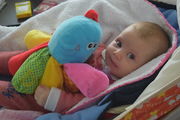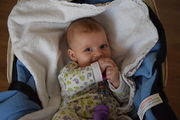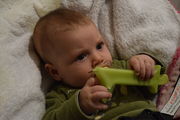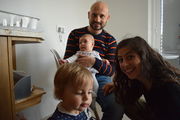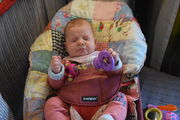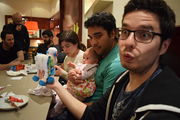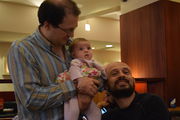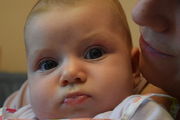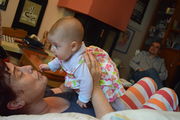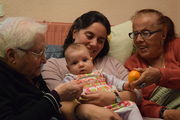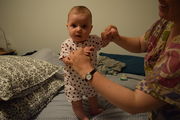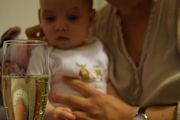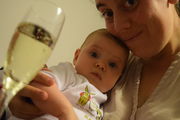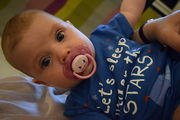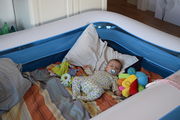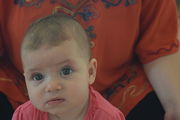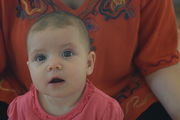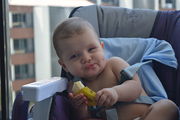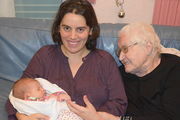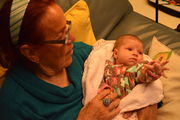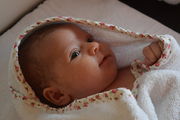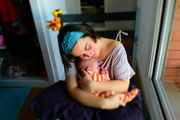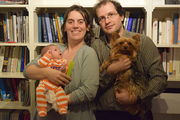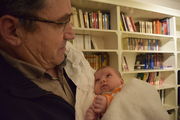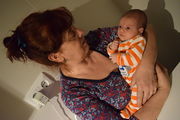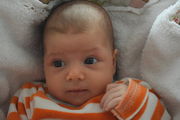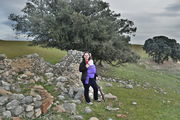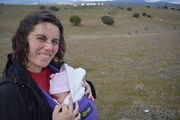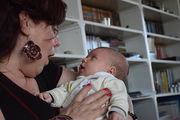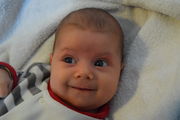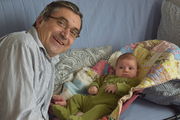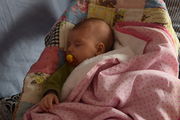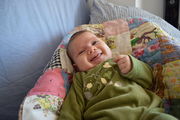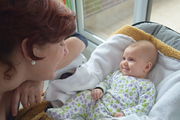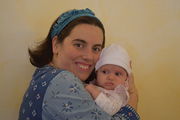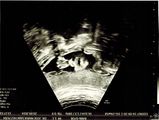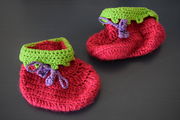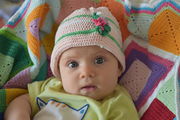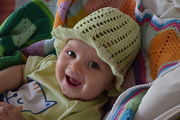
Julia (3 January (2015)) is our daughter, first and, so far, only child.
Contents |
Raising Julia
Attachment parenting
Attachment parenting means to follow your instincts in parenthood which, in general, translates into being there for the baby when she needs it. That is, to pick her up when she cries, to breastfeed her on demand, to have her always nearby, to carry her around as much as possible (using baby wraps or a baby carrier), co-sleeping... As a result, the baby feels secure and nurtured enough ("secure attachment") to develop independence and self-confidence when ready. But above all, this is the most enjoyable way of raising your baby.
Some interesting sites:
- http://www.attachmentparenting.org
- http://www.crianzaautorregulada.com/articulos/por-que-elijo-la-crianza-con-apego
The leading proponents of attachment parenting are William and Martha Sears. In Spain, the best advocate of "crianza con apego" is Dr. Carlos Gonzalez. He has written a few beautiful and fun books on the subject: Bésame mucho: Cómo criar a tus hijos con amor, Un regalo para toda la vida: Guía de la lactancia materna, Creciendo Juntos etc. Some interesting videos from him are: El sueño en bebés. He says things like:
- La infancia es fugaz. Que nuestra obsesión por corregirla no nos impida disfrutarla.
- Yo no dejaría jamás llorar a mi hijo. Ni a mi esposa, ni a mis padres ni a mis amigos. Cuando una persona a la que quiero llora, voy a ver qué le pasa e intento consolarla.
- Malcriar significa criar mal, con poco cariño, sin cubrir las necesidades básicas del niño.
La crianza con apego suele despertar muchas críticas pero todas son bastante rebatibles...
Co-sleeping
It is a sensible and practical thing to do, as many people put it, although there are also studies and interesting books to read on the subject. The most famous one is Sleeping with your baby by James J. McKenna.
Quite naturally, we have been drifting towards co-sleeping with Julia, not only room but also bed sharing.
For her first month, Julia would sleep in our baby stroller cradle, which in our case is removable. We started by placing it on the floor, next to my side of the bed, in order to see her from above during her sleep. Soon enough Fabrice suggested to plug her onto our (large, 160cm-) bed, between us, and that worked even better since I could help her to sleep quite easily without getting up. Just stroking her head or putting back her fallen-out pacifier. Still, after a couple of weeks, it felt like that extra barrier was not needed and things could be made even easier. Even being so physically close to us, Julia would wake up the moment she was placed in the cradle if not deeply asleep. This was annoying... Specially at 3am after gently and quite successfully breastfeeding her to sleep. Furthermore, the fact that we had a trip to France soon ahead of us made me wish we did not need the cradle (we have a rather small car).
By the second month we decided to remove it completely. We placed Julia on the bed, between us, on her little mattress (in order to give us a sense of the room she was taking) and barricaded by Fabrice's side with a pillow. They say that breastfeeding mothers are really tuned to their babies and would never roll onto them, also tend to synchronise their sleep patterns. I quickly realised that this was completely true and I sleep happily in close proximity without any fear. However, for fathers, things are not as natural. They typically fall into a much deeper sleep and need time to develop the instinct to keep the baby safe. This is why we have this pillow, that is covered by a sheet so that it is fixed and there is no risk of falling on top of Julia.
We also follow all the usual recommendations not to have extra pillows or toys or blankets in bed, not to leave any space where she could fall into and not take drugs or alcohol.
It feels completely natural. It also facilitates breastfeeding since it allows me and Julia to barely wake up and go back to sleep without any problem most of the nights. When she does wakes up, I know it instantly and can react quickly to her demands so that she is never fully awake, does not get to the point of crying and does not choke. Cry-less nights! Already interesting. But cosleeping goes further than just these convenient and practical reasons. I love to sleep so close to this beautiful baby, wake up in the mornings to her joyful smile. If she is a bit excited at bed time, I simply caress her and hold her hands for a little while and she quietly and smoothly falls asleep. It feels right and both Fabrice and me, enjoy it immensely.
Baby-led weaning
Baby-led weaning lets the weaning process in the hands of the baby. This is the method we have chosen and you can follow our progress in our page on "Julia-led weaning".
Growing up with several languages
Cada uno hablamos a Julia en nuestro idioma materno, Elena en español y Fabrice en francés. Este es el método más practicado en el multilingüismo (One person one language).
Las primeras palabras de Julia fueron papá y mamá en el mismo día, mientras viajábamos en el tren nocturno de Moscú a St Petersburgo. Lo grabamos en vídeo.
Playful parenting
PET parenting, Playful parenting
Education and creativity
"The best teachers are those who show you where to look, but don't tell you what to see". Alexandra K. Trenfor
- La educación prohibida: Una película sobre la educación centrada en el amor, el respeto, la libertad y el aprendizaje. ("¿Pero no quieres tener un título, ser alguien en la vida? Yo ya soy alguien en la vida!")
- Born to learn is a fun, thought-provoking series of animations that illustrate ground-breaking new discoveries about how humans learn. Also Responsible Subversive, a social network for people who want to connect and discuss how to change the world by changing the way we raise our children.
- ¿Te atreves a soñar? by inKNOWation España.
- Changing Education Paradigms, by Ken Robinson RSAnimated
- Where good ideas come from?, by Steven Johnson, RSAnimated
- Drive: The surprising truth about what motivates us, by Dan Pink, RSAnimated
- The Empathic Civilisation (by Jeremy Rifkin, RSAnimated)
- What if money was no object? by Alan Watts
- File:On the Psychology of Scientific Creativity--Migdal.pdf by A. B. Migdal (L. D. Landau Institute of Theoretical Physics, Moscow), Contemporary Physics, 20, 121 (1979).
Resources for Infant Educarers (RIE)
Emmi Pikler & Magda Gerber
- http://www.magdagerber.org/
- http://pikler.org/PiklerPractices.html
- http://www.janetlansbury.com/2013/12/rie-parenting-basics-9-ways-to-put-respect-into-action/
- http://babygooroo.com/2014/04/rie-parenting/
1. Talk to your baby
RIE recommends informing your baby about what you are going to do before you do it, such as ‘I’m going to pick you up now’. This doesn’t mean that lullabies and gooing and gagaing are out. Rather, it means that children will be less anxious if they are told what is going to happen to them before it happens. It will also help with their language development.
2. Let your baby cry
‘When your baby cries…wait,’ writes Carlisle Solomon.
This isn't laziness or neglect. Instead, it allows you to observe and work out the cause of the distress, and it gives your baby the opportunity to learn how to self-soothe and the freedom to express their emotions.
‘Don’t distract your baby from her feelings by bouncing her on your knee or singing a cheery song,’ writes Carlisle Solomon. ‘Trying to jolly your baby out of crying will only make her feel disconnected and out of tune with you. Imagine if you were upset and your trusted other responded with a big grin, spoke in a singsongy voice, and tried to humor you out of it.’
3. Dummies
RIE is not anti-dummies as has been reported. Instead, Carlisle Solomon cautions against forcing a dummy into a child’s mouth if it clearly doesn’t want it.
‘If you choose to offer a pacifier, it’s very important that as soon as you see your baby push the pacifier out of her mouth when it’s offered, you put it away.’
4. Caring routines
Rather than seeing routines such as nappy changing, bathing and feeding as labourious tasks to be rushed through, try to slow down and use them as a caring opportunity to communicate and bond.
‘[T]his helps the baby feel secure because he learns to anticipate what will happen next and can participate when he is able.’
5. Baby-led feeding
According to RIE parenting, part of respecting your child is also respecting their appetite.
‘Babies should never be coaxed, cajoled, or forced to eat. They should eat however much they want, and not one bite more!’ writes Carlisle Solomon.
‘To help baby learn to eat when he’s hungry and stop eating when he’s satiated, we need to observe closely so that we’re attuned to his cues. Then we need to honor what the baby communicates to us.’
6. Prioritise your baby’s sleep schedule
RIE considers adequate sleep to be essential for a happy, healthy baby and a calm family. This means establishing a sleep routine and prioritising it — even when granny drops in and wants a cuddle.
The principle of allowing babies to cry so they learn to self-sooth also applies to sleeping — within reason.
‘Of course, if your baby’s crying is ramping up and she’s sounding distressed, then by all means, go into her room to reassure her. It’s best to go to her before she’s so over-wrought that she needs a lot of help to calm.’
7. Limiting intervention
Rather than rushing in to solve our children’s problems we should allow them the opportunity to find their own solutions and to discover and cope with the fact that life involves struggle, disappointment and compromise.
‘When an adult routinely steps in to solve every little, or big problem, a baby can quickly learn to look for help rather than attempt to find a solution for himself, and giving up and relying on an adult for every little thing becomes a habit,’writes Carlisle Solomon.
‘Not only is a child robbed of a sense of self-satisfaction and accomplishment, but his sense of confidence and self-reliance can begin to erode as well.’
8. Toys
This is one of the most misreported aspects of RIE. The philosophy is not anti-toys, but instead recommends simple toys such as a cotton napkin, plastic hair rollers, colanders, pot holders, plastic nesting cups, or an empty plastic bottle.
According to this philosophy, the more passive the toy, the more active the child needs to be to play with it.
9. Praise
RIE is not against praising children as has been reported. But instead of telling your child they are as talented as Rembrandt every time they pick up a crayon, Carlisle Solomon recommends praising kids for doing difficult social or process things like waiting, sharing or persistence.
In other instances, parents should ‘reflect what we see instead of praising.’ For example: ‘You got those rings apart’ or 'You put the nesting cups together.’
As with any parenting philosophy, it’s unlikely that every recommendation fits every family and every child. But amongst the other parenting trends from Tiger Moms and Helicopter Parenting, RIE seems pretty tame.
? Allow your baby to participate in childcare. Tell your child what you'll do before you do it. Informing him about what will happen next -- like a diaper change -- can help him feel more secure and lead to two-way communication down the road, says O'Sullivan.
? Honor what he can do physically. The group suggests not putting a baby into a position he can't get into himself, such as propping him up with pillows in a sitting position. Healthy babies will invariably reach these developmental milestones, argues RIE, and rushing the process may frustrate them and even lead them to feel disappointed in themselves.
? Sit and observe. To see your child for who he is and witness small development changes as they occur, RIE advocates that parents watch their child play, without distractions or planned activities, ideally for at least 15 minutes three times a day. Occasionally, the parent should comment nonjudgmentally about the child's activity -- "sportscasting" in the RIE lingo.
? Follow your baby's lead. During playtime, let him choose a toy or a new place to explore. That means making your home baby-safe is critical, so your child can have more freedom to wander. In the spirit of doing less, RIE asserts that a child who is frustrated by, say, a ball that has rolled under a chair shouldn't be helped immediately. Finding his own solutions can make for a more valuable lesson.
? Turn off the television. Playing without the distraction of the TV lets your child decide what interests him and may even help him develop concentration.
Montessori
The problem of applying it at a young age...
Waldorf
Pictures
Second trimester
El 27 de junio, unos días antes de cumplir 6 meses, empezamos el Julia-led weaning con un poco de plátano
First trimester
Dinrid llorando un poquito a papá, pero muy guapa en el vestido que le regaló Juan Pablo.
Intrauterine
First costume of Julia for Halloween 2014:

Links
Regalos de la abuela
Regalos de Julia y para Julia
Cumple de papá
Para su 38 cumpleaños, el 30 de septiembre de 2015 (usando el programa Comic life):
